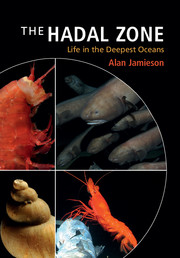Book contents
- Frontmatter
- Dedication
- Contents
- Preface
- Acknowledgements
- Part I History, geology and technology
- Part II Environmental conditions and physiological adaptations
- 4 The hadal environment
- 5 Hydrostatic pressure
- 6 Food supply to the trenches
- Part III The hadal community
- Part IV Patterns and current perspectives
- Appendix
- References
- Index
- Plate section
5 - Hydrostatic pressure
from Part II - Environmental conditions and physiological adaptations
Published online by Cambridge University Press: 05 February 2015
- Frontmatter
- Dedication
- Contents
- Preface
- Acknowledgements
- Part I History, geology and technology
- Part II Environmental conditions and physiological adaptations
- 4 The hadal environment
- 5 Hydrostatic pressure
- 6 Food supply to the trenches
- Part III The hadal community
- Part IV Patterns and current perspectives
- Appendix
- References
- Index
- Plate section
Summary
Every life form on Earth experiences some degree of pressure, but none more so than those inhabiting the hadal zone. In the deep sea, pressure is a key physical parameter that has influenced the evolution and distribution of both microorganisms and macroorganisms (Bartlett, 2002). Pressure represents an absolute, continuous gradient from the sea surface to the deepest place on Earth, the Mariana Trench (~11 000 m) and it is one of the only parameters to maintain a linear relationship with depth. Adaptation to high hydrostatic pressure is an essential prerequisite for survival at hadal depths as this zone accounts for the deepest ~45% of the total depth range of the oceans (Jamieson et al., 2010). Hydrostatic pressure increases by 1 atmosphere (atm) every 10 m depth. Pressure is often expressed in Megapascal (MPa) or bar (bar) and all are relatively easy to covert; 1 atm = 1 bar = 0.1 MPa = ~10 m depth. The pressure found at hadal depths ranges from ~600 to 1100 atm (6000 m to 11 000 m).
The effects of hydrostatic pressure and survival in the deep sea have been reviewed several times (e.g. Somero, 1992; MacDonald, 1997; Pradillon and Gaill, 2007). It is not the intention of this chapter to review all aspects of high pressure and other adaptations, which could be another book in itself, but rather to highlight some of adaptations that are particularly relevant to or identified from hadal organisms.
- Type
- Chapter
- Information
- The Hadal ZoneLife in the Deepest Oceans, pp. 92 - 108Publisher: Cambridge University PressPrint publication year: 2015



